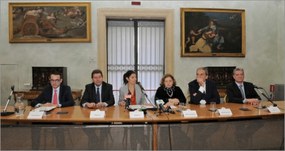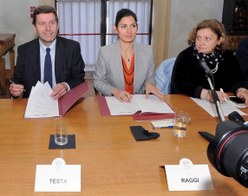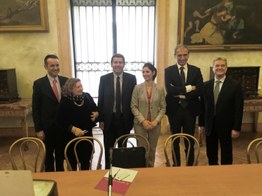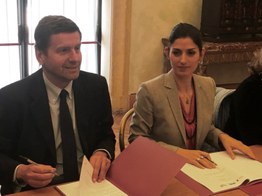Environment: The Municipality of Rome towards more sustainable living and climate action
5/4/2018
 40% cuts in CO2 emissions, from renewable energy and improving energy efficiency such as public and residential buildings, lighting, mobility and waste, climate change and their likeliness to adopt adapting and mitigating behaviours. These are the goals set by the agreement among Roma Capitale, ENEA and GSE, signed at the Municipality of Rome (Campidoglio) by the mayor Virginia Raggi and by the presidents Federico Testa (ENEA) and Francesco Sperandini (GSE).
40% cuts in CO2 emissions, from renewable energy and improving energy efficiency such as public and residential buildings, lighting, mobility and waste, climate change and their likeliness to adopt adapting and mitigating behaviours. These are the goals set by the agreement among Roma Capitale, ENEA and GSE, signed at the Municipality of Rome (Campidoglio) by the mayor Virginia Raggi and by the presidents Federico Testa (ENEA) and Francesco Sperandini (GSE).
 Six technical tables will be created based on this agreement for identifying priority areas to reduce urban pollution and energy consumption in residential buildings and PA, including sports facilities, hospitals, schools and universities. The use and potential of different sources of renewable energy (photovoltaic, small hydro power, small and micro-wind, solar heating at low, medium and high temperature, bioenergy), energy efficiency in public buildings and residential lighting and sustainable mobility on the entire municipal territory will be top priority at the meetings with municipalities, citizens, companies, and associations.
Six technical tables will be created based on this agreement for identifying priority areas to reduce urban pollution and energy consumption in residential buildings and PA, including sports facilities, hospitals, schools and universities. The use and potential of different sources of renewable energy (photovoltaic, small hydro power, small and micro-wind, solar heating at low, medium and high temperature, bioenergy), energy efficiency in public buildings and residential lighting and sustainable mobility on the entire municipal territory will be top priority at the meetings with municipalities, citizens, companies, and associations.
 The 2019 Sustainable Energy and Climate Action Plan (SEAP) will be drafted and presented following discussions between experts and all stakeholders. This procedure is a prerequisite to the sustainable, environmental and energy action plan that Roma Capitale has undertaken by joining the "Covenant of Mayors for Climate & Energy", the initiative promoted by the EU to involve local administrations in the fight against climate change with ENEA as Italian coordinator to support the municipalities in drafting the 'Action Plan' and in promoting energy efficiency.
The 2019 Sustainable Energy and Climate Action Plan (SEAP) will be drafted and presented following discussions between experts and all stakeholders. This procedure is a prerequisite to the sustainable, environmental and energy action plan that Roma Capitale has undertaken by joining the "Covenant of Mayors for Climate & Energy", the initiative promoted by the EU to involve local administrations in the fight against climate change with ENEA as Italian coordinator to support the municipalities in drafting the 'Action Plan' and in promoting energy efficiency.
The alliance between Roma Capitale, ENEA and GSE will transform Roma Capitale into a more sustainable, resilient and inclusive city, with a plan to cut emissions (-90%CO 2 by 2050) and in final energy consumption (-28% by 2030).
 According to the elaboration on data from the Information System on the operations of public bodies (SIOPE), in 2016 the total PA energy costs for electricity, heating and transport exceeded 3.3 billion euro, of which 117 million spent by the central government (35% for electricity, 4% for gas and 61% for fuels), 1.85 billion in suburban administrations , 220 million in provinces managing most school buildings and 1.13 billion euro in public hospitals.
According to the elaboration on data from the Information System on the operations of public bodies (SIOPE), in 2016 the total PA energy costs for electricity, heating and transport exceeded 3.3 billion euro, of which 117 million spent by the central government (35% for electricity, 4% for gas and 61% for fuels), 1.85 billion in suburban administrations , 220 million in provinces managing most school buildings and 1.13 billion euro in public hospitals.
